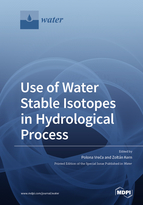Use of Water Stable Isotopes in Hydrological Process
A special issue of Water (ISSN 2073-4441). This special issue belongs to the section "Hydrology".
Deadline for manuscript submissions: closed (1 December 2019) | Viewed by 76004
Special Issue Editors
Interests: water cycle; isotopes; changes in time and space; measurement traceability; statistical analysis; water management
Special Issues, Collections and Topics in MDPI journals
Interests: environment and climate change; biogeochemistry; environmental isotopes; dendroclimatology; quaternary geochronology
Special Issues, Collections and Topics in MDPI journals
Special Issue Information
Dear Colleagues,
Water is vital for all known forms of life and is transported continuously through the different spheres of Earth with the water cycle: Evaporation, transpiration, condensation, precipitation, runoff, etc. As such, fresh water plays an important role in the world economy as well. Cities have been built around reliable sources of water since ancient times, and a considerable amount of available freshwater is used for irrigation and other agricultural activities to supply humanity.
Stable (16O, 17O, 18O, 1H, 2H) and radioactive (3H) water isotopes as well as other tracers are powerful tools to track the path of water molecules in the water cycle from precipitation to surface and groundwater and, further, to drinking water supplies. They are commonly used to trace the source of water and its flow pathways or to quantify exchanges of water, solutes, and particulates between hydrological compartments during different hydrological processes. In the last decade, a considerable number of studies have been published on the use of water isotopes in hydrological processes and the number is ever growing due to the development of new measurement techniques (i.e., laser spectrometry) that allow measurements of stable isotope ratios at an even higher resolution. However, accurate and precise measurements are required to provide new data comparable in space and time or with data obtained with classical isotope ratio mass spectrometry.
This Special Issue addresses the current state-of-the-art methods, applications, and hydrological process interpretations using stable and radioactive water isotopes in the whole water cycle. Contributions related to measurement traceability (comparison of different measurement techniques), conceptual network development, and long-term maintenance on local to regional scale, as well as papers on different statistical data evaluation approaches, are highly welcome.
Dr. Polona Vreča
Dr. Zoltán Kern
Guest Editors
Manuscript Submission Information
Manuscripts should be submitted online at www.mdpi.com by registering and logging in to this website. Once you are registered, click here to go to the submission form. Manuscripts can be submitted until the deadline. All submissions that pass pre-check are peer-reviewed. Accepted papers will be published continuously in the journal (as soon as accepted) and will be listed together on the special issue website. Research articles, review articles as well as short communications are invited. For planned papers, a title and short abstract (about 100 words) can be sent to the Editorial Office for announcement on this website.
Submitted manuscripts should not have been published previously, nor be under consideration for publication elsewhere (except conference proceedings papers). All manuscripts are thoroughly refereed through a single-blind peer-review process. A guide for authors and other relevant information for submission of manuscripts is available on the Instructions for Authors page. Water is an international peer-reviewed open access semimonthly journal published by MDPI.
Please visit the Instructions for Authors page before submitting a manuscript. The Article Processing Charge (APC) for publication in this open access journal is 2600 CHF (Swiss Francs). Submitted papers should be well formatted and use good English. Authors may use MDPI's English editing service prior to publication or during author revisions.
Keywords
- Water cycle
- Isotope hydrology
- Measurement traceability
- Precipitation (rain and snow)
- Surface water
- Groundwater
- Water management
- Networks and data bases
- Statistical evaluation







